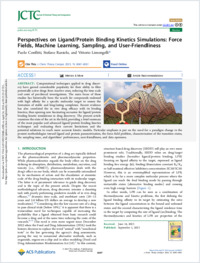Perspectives on ligand/protein binding kinetics simulations : Force fields, machine learning, sampling, and user-friendliness
- Conflitti, Paolo ORCID Euler Institute (EUL), Università della Svizzera italiana, Switzerland
- Raniolo, Stefano ORCID Euler Institute (EUL), Università della Svizzera italiana, Switzerland
- Limongelli, Vittorio ORCID Euler Institute (EUL), Università della Svizzera italiana, Switzerland - Department of Pharmacy, University of Naples “Federico II”, 80131 Naples, Italy
- 2023
Published in:
- Journal of chemical theory and computation. - 2023, vol. 19, no. 18, p. 6047-6061
English
Computational techniques applied to drug discovery have gained considerable popularity for their ability to filter potentially active drugs from inactive ones, reducing the time scale and costs of preclinical investigations. The main focus of these studies has historically been the search for compounds endowed with high affinity for a specific molecular target to ensure the formation of stable and long-lasting complexes. Recent evidence has also correlated the in vivo drug efficacy with its binding kinetics, thus opening new fascinating scenarios for ligand/protein binding kinetic simulations in drug discovery. The present article examines the state of the art in the field, providing a brief summary of the most popular and advanced ligand/protein binding kinetics techniques and evaluating their current limitations and the potential solutions to reach more accurate kinetic models. Particular emphasis is put on the need for a paradigm change in the present methodologies toward ligand and protein parametrization, the force field problem, characterization of the transition states, the sampling issue, and algorithms’ performance, user-friendliness, and data openness.
- Collections
- Language
-
- English
- Classification
- Medicine
- License
- Open access status
- hybrid
- Identifiers
-
- DOI 10.1021/acs.jctc.3c00641
- ARK ark:/12658/srd1328332
- Persistent URL
- https://n2t.net/ark:/12658/srd1328332
Statistics
Document views: 155
File downloads:
- Conflitti_2023_jchemtheorycomput: 430
